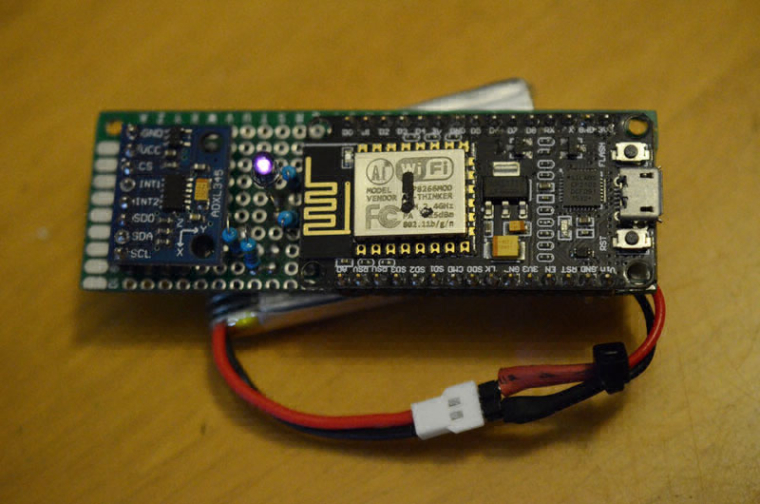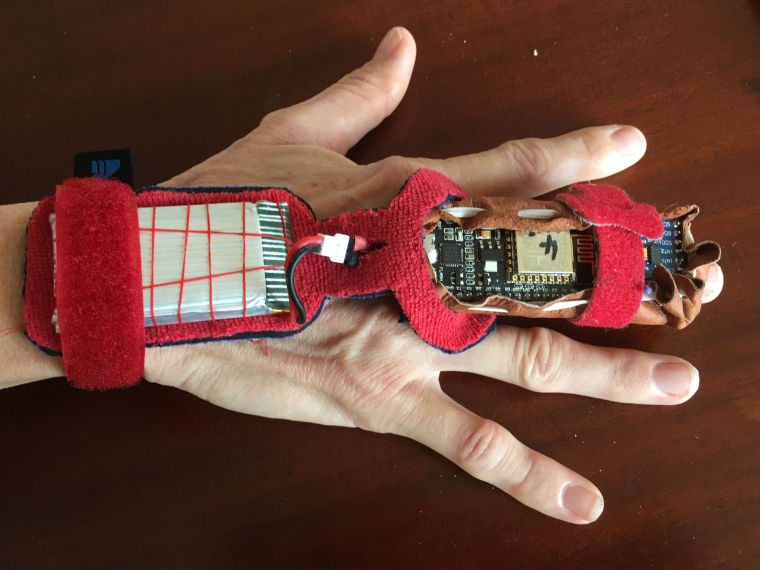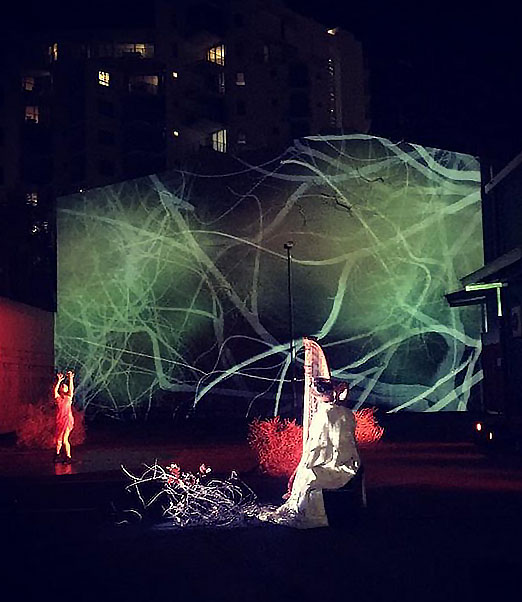OSC wireless wearable sensors
-
very interesting!
I'm watching the project on github now.
I would be interested in building a unit once a how to is available.
-
Really cool project, also watching the project and can't wait what you guys create in the end :)
-
@DusX said:
I would be interested in building a unit once a how to is available.
Hi Ryan,
OK, I will let you know how we get on.
cheers
bonemap
-
Appreciated,
I'm ready to start mixing my media control ( read Isadora ) work with my costume design work.
-
Very interesting indeed! You have my attention!
-
Hi,
We have the wireless sensors up and running. I have added a infrared LED for position/proximity tracking.
Still at the prototype stage but ready for use in production.
The range has been tested with a 2.4ghz wireless router at 40 metres with no indication of degraded performance. The battery life has exceeded six hours of non-continuous use.There is a 'how to' here: https://reprage.com/post/Dance...
The code for the board and Isadora patches are here: https://github.com/bonemap/Dan...
We are using AtomIO and PlatformIO to update the code on the board using the NodeMCU's micro USB port, including the wireless settings SSID/password/port info etc. https://atom.io/, http://platformio.org/
Lots of possibilities for this unit. For example, it can be wearable (see image below), attached to a physical object (hoops, tubes, boards, trapeze, costumes etc.) to track its orientation and multiple devices can be used simultaneously with unique OSC streams for X,Y, Z movement, vibration and rotation. The IR LED has potential to provide proximity using a separate camera tracking set-up and when not occluded. A future prototype will mount the IR LED in a thimble or plectrum so that it extends to the tip of a finger and is less often occluded when the sensor unit is worn on a hand.


Short video here... but will post with a video of the unit in production soon...
-
I will build a copy once I return from the werkstatt. Very much into this.
Perhaps it's noted (haven't read the how to yet) what language is being used for the micro processor coding?
Update... checked the github and see the code is c++ ☺
-
Is there a possibility of creating a similar function using this on a smartphone? Isn't a smartphone already a wifi transmitter and has an accelerometer?
I'm a novice, just wondering..
-
@CarlMDB said:
Isn't a smartphone already a wifi transmitter and has an accelerometer
Hi @CarlMDB,
Thank you for your comment. I take your point, and short answer is yes these units are an alternative to an expensive smartphone/ipod that has the same functionality. However, this is much lower cost per unit and can be used with multiple units simultaneously, is lighter, simpler, can be incorporated into props, costumes and we have the satisfaction of building something ourselves. I have 6 x prototypes of these devices for component cost of under US$20 each, not sure that I would be able to get 6 smartphones for the same price point and have as much flexibility of how they can be integrated into use. Smartphones do a lot more than these units so I am not sure that the comparison is worthwhile. I can imagine a performer wearing a bunch of smartphones and that has the potential to tell particular visual narratives. What is the visual narrative that these devices tell? I think it is a bit different if only that we have engaged in the agency of making the device ourselves.
regards
bonemap

-
"we have the satisfaction of building something ourselves"
I completely understand this.
I am a member of SOPWAMTOS: "Society of People Who Actually Make Their Own Shit ". I imagine many Isadora users are as well.
-
@CarlMDB said:
SOPWAMTOS: "Society of People Who Actually Make Their Own Shit ".
Thanks for that - I love it!
regards,
bonemap -
This is very cool. Following closely!
-
@bonemap What's the positional drift rate on these devices? Last time I checked the accelerometers were not better than about 1m per 1 minute, which really was a stopper for me.
Thanks for sharing!
-
@eight said:
the positional drift rate
These accelerometers do have some drift, but I would be surprised if it is to the extreme that you have described. I have used them for extended periods (over 6 hours continuous) with negligible issues with drift, however I would not say there is no drift. They appear to be much better than the accelerometers I have been using since 2011. The way I am using them currently does not require accurate tracking of position over time or distance. I am using numerical decay and smoothing that responds to the force of directional movements, rotation and orientation of the device. These are like exaggerations of directional movement that are always trying to decay back to the raw reading of the accelerometer data. The numerical data is filtered and passed to numerous 3D player assets that flock and swarm synchronized with rotation and direction of the performers hand movements. The spatial representation of these swarms as projections tracking over physical distances is not going to be achieved with the accelerometer data. There are a couple of other options for spatial tracking, one is a camera vision system that tracks IR LEDS mounted on the device (reducing the battery duration significantly), the other is Bluetooth triangulation (there appears to be a Bluetooth beacon on the NodeMCU) however, the programming task of implementing the Bluetooth option is out of my reach.
Cheers,
bonemap
-
Hi,
This crowd funded project may be of interest to anyone looking at wearable sensors: synapseWear
regards
bonemap
-
@bonemap said:
post with a video of the unit in production
An update to the post with a video representation of the wearable sensors in action. I was sick with the flu when this was running, so I have relied on low res 'quick and dirty' social media video documentation made by audience members. It is one scene in the work.

In this iteration the dancer is wearing three of the ESP8266 based wifi modules with accelerometers sending data to Isadora. One is incorporated into a chest plate shaped as a rib cage and another two - one for each hand. In the video, the chest mounted module is affecting the orientation of the 3D shader ("Seascape" by Alexander Alekseev aka TDM - 2014) using custom Isadora GLSL shader inputs. The two hand accelerometer modules provide data for the 'twig' like 3D objects. The wave height of the Seascape shader is also linked to the sound frequency of the analogue harp music captured with a pick-up. The work was presented in a carpark September 2017.
We are looking at the next stage prototype now that might use some form of (wifi, bluetooth or NFC) signal strength detection to develop proximity data between the modules, in an attempt to get autonomous relational data streams from the body (centre of gravity) and the limbs (as orbiting/satellite/moving points).
The other direction we are exploring is a module with interchangeable sensor components that get 'designed' into a custom PCB board and wearable enclosure. I am very interested in a modular system that can be used as a flexible solution - not just wearable - but also mountable. For example these thermal imaging sensors mounted for motion tracking which means looking into wireless video on the ESP8266. If anyone has already tried this it would be great to hear about it.
Best Wishes
bonemap
-
-
@bonemap said:
Here is another approach from the UK: MiMu gloves
I think I'm in love!
Unfortunately, I can't afford to buy any more equipment at the moment. Fortunately, they're not in stock right now so the state of my bank account doesn't matter. Wish I knew how much they cost though...
Best wishes,
Woland
-
@bonemap said:
the other is Bluetooth triangulation (there appears to be a Bluetooth beacon on the NodeMCU) however, the programming task of implementing the Bluetooth option is out of my reach
I may know someone who might be able to help with that. I'll DM you some info.
Best wishes,
Woland
-
@bonemap said:
Hi,
Here is another approach from the UK: MiMu gloves
Best Wishes
bonemapWhile we’re mentioning wireless wearables, of course there’s always the Myo Armband. This thread is starting to turn into a lovely repository for fun wireless wearables, so I thought I’d mention that one.
Best wishes,
Woland